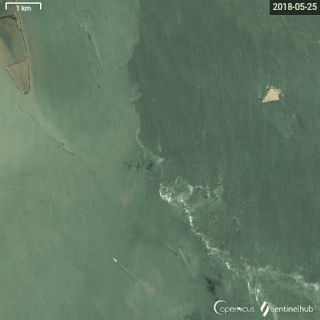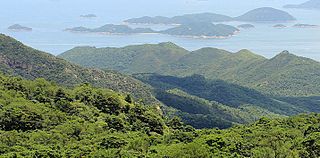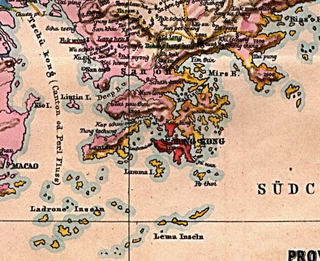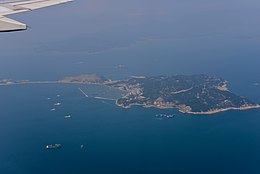
The Hong Kong Special Administrative Region (HKSAR), can be divided into three geographical regions: Hong Kong Island, Kowloon, and the New Territories. Hong Kong is a coastal city and major port in Southern China, bordering Guangdong Province through the city of Shenzhen to the north and the South China Sea to the east, south, and west. Hong Kong and its 260 nearby islands and peninsulas are located at the mouth of the Pearl River Delta. The area of Hong Kong is distinct from Mainland China, but is considered a part of "Greater China".

Lantau Island is the largest island in Hong Kong, located west of Hong Kong Island and the Kowloon Peninsula, and is part of the New Territories. Administratively, most of Lantau Island is part of the Islands District of Hong Kong. A small northeastern portion of the island is located in the Tsuen Wan District.

The Pearl River Delta Metropolitan Region is the low-lying area surrounding the Pearl River estuary, where the Pearl River flows into the South China Sea. Referred to as the Guangdong–Hong Kong–Macao Greater Bay Area in official documents, the region is one of the most densely populated and urbanized regions in the world, and is considered a megacity by numerous scholars. It is currently the wealthiest region in Southern China and one of the wealthiest regions in China along with the Yangtze River Delta in Eastern China and Jingjinji in Northern China. Most of the region is part of the Pearl River Delta Economic Zone, which is a special economic zone of China.

The Hong Kong–Zhuhai–Macau Bridge (HZMB) is a 55-kilometre (34 mi) bridge–tunnel system consisting of a series of three cable-stayed bridges, an undersea tunnel, and four artificial islands. It is both the longest sea crossing and the longest open-sea fixed link in the world. The HZMB spans the Lingding and Jiuzhou channels, connecting Hong Kong and Macau with Zhuhai— a major city on the Pearl River Delta in China.

The Lingdingyang Bridge is one of the bridges in the Shenzhen-Zhongshan link. The bridge was proposed by former Zhuhai prefecture mayor in the late 1980s to link Zhuhai and Hong Kong at Qi'ao and Tuen Mun, across the Lingdingyang, Pearl River estuary.

Tung Chung, meaning "eastern stream", is an area on the northwestern coast of Lantau Island, Hong Kong. One of the most recent new towns, it was formerly a rural fishing village beside Tung Chung Bay, and along the delta and lower courses of Tung Chung River and Ma Wan Chung in the north-western coast of Lantau Island. The area was once an important defence stronghold against pirates and foreign military during the Ming and the Qing dynasties.

Land reclamation, usually known as reclamation, and also known as land fill, is the process of creating new land from oceans, seas, riverbeds or lake beds. The land reclaimed is known as reclamation ground, reclaimed land, or land fill.

The Soko Islands are a group of islands in Hong Kong. The group consists of Tai A Chau, Siu A Chau and several smaller nearby islands, in the southwesternmost waters of the territory, to the southwest of Lantau Island.

Hengqin is an island that lies mostly in Zhuhai, a prefecture-level city and special economic zone in Guangdong Province of the People's Republic of China. It has a population of about 3,000. Parts of Hengqin are leased to Macau by the State Council of the People's Republic of China, starting from 2009, mostly to house the new campus of the University of Macau. In the leased parts of the island, Macau law applies.

The Wanshan Archipelago, formerly known as the Ladrones Islands, is a 104-island archipelago that is a part of Xiangzhou District in Zhuhai, Guangdong Province, China.

North Lantau Highway is an expressway forming part of Hong Kong's Route 8, linking Hong Kong International Airport and Lantau Island with the rest of the territory. The road has three lanes in each direction for its entire length with full-width hard shoulders for emergencies and breakdowns. The speed limit is 110 kilometres per hour (68 mph) for most of its length, the highest of any road in Hong Kong.

North Lantau New Town is the newest of the nine new towns in Hong Kong, a special administrative region of China, located on the northern coast of the Lantau Island in the New Territories. It covers Tung Chung, Tai Ho Wan, Siu Ho Wan, other parts of northeast Lantau Island, and the reclaimed land along the coast between them. It is the only new town in the Islands District and the youngest new town in Hong Kong. As the commercial, residential and community facilities in the New Town are concentrated in Tung Chung, it has been renamed Tung Chung New Town in recent official government documents.
The Wanshan Archipelago Campaign (万山群岛战役) was a campaign fought between nationalist and communist forces for the control of Wanshan Archipelago, and resulted in communist victory. The archipelago consists of 48 islands strategically located at the mouth of the Pearl River, a chokepoint on the communication lines to Hong Kong and Macau. The largest island is the Laurel Mountain Island, which was formerly known as Trash Tail Island. Other major islands include Outer Linding Island, Dong'ao (东澳) Island, Tri-gate Island, Greater Ten-thousand Mountain Island, Lesser Ten-thousand Mountain Island, Burden Pole Islands, and Jianpeng (佳蓬) Islands.

Nei or Inner Lingding Island, formerly romanized as Lintin or Lin Tin Island, is an island in the Pearl River estuary in the southeastern Chinese province of Guangdong. Although it is located closer to the eastern shore of the estuary, it was until 2009 administratively part of the prefecture-level city of Zhuhai, whose main administrative center is located on the west shore of the river. The jurisdiction of Nei Lingding Island was handed over to Shenzhen in 2009.

Since 1949, China has carried out extensive land reclamation projects. It is among the countries which have built the most artificial land; from 1949 to 1990s, the total area of land reclaimed from the sea of China was about 13,000 km2.

The reclamation of land from the ocean has long been used in mountainous Hong Kong to expand the limited supply of usable land with a total of around 60 square kilometres of land created by 1996. The first reclamations can be traced back to the early Western Han dynasty, when beaches were turned into fields for salt production. Major land reclamation projects have been conducted since the mid-19th century.

Lantau Tomorrow Vision, also known as the Kau Yi Chau Artificial Islands, is a postponed development project in Hong Kong proposed by the previous two Chief Executives of Hong Kong. The previous Chief Executive Carrie Lam proposed in her 2018 policy address which includes the creation of a third core business district by constructing artificial islands with a total area of about 1,700 hectares through massive land reclamation near Kau Yi Chau and Hei Ling Chau of the eastern waters of Lantau Island. The project has met with controversy and opposition for its high cost of estimated HK$580 billion – amounting to half of the city's fiscal reserves, as well as environmental concerns. In February 2024 the financial secretary said the project would be postponed after looking at its finances, but insisted it would not be cancelled.

Oyster Bay, previously known as Siu Ho Wan in proposals, is an MTR station on the Tung Chung line to be constructed southwest of Siu Ho Wan depot in Siu Ho Wan, on Lantau Island. The station will be built at-grade around existing Tung Chung line tracks. The construction of the station was gazetted by the Hong Kong Government in June 2021. The station is expected to open for service in 2030, with the depot remaining in use.



















